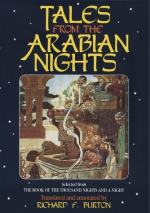[FN#156] Arab. “Hijl,” the bird is not much prized in India because it feeds on the roads. For the Shinnar (caccabis) or magnificent partridge of Midian as large as a pheasant, see “Midian Revisted” ii. 18.
[FN#157] Arab. “Suf;” hence “Sufi,"=(etymologically) one who wears woollen garments, a devotee, a Santon; from =wise; from =pure, or from Safa=he was pure. This is not the place to enter upon such a subject as “Tasawwuf,” or Sufyism; that singular reaction from arid Moslem realism and materialism, that immense development of gnostic and Neo-platonic transcendentalism which is found only germinating in the Jewish and Christian creeds. The poetry of Omar-i-Khayyam, now familiar to English readers, is a fair specimen; and the student will consult the last chapter of the Dabistan “On the religion of the Sufiahs.” The first Moslem Sufi was Abu Hashim of Kufah, ob. A. H. 150=767, and the first Convent of Sufis called “Takiyah” (Pilgrimage i. 124) was founded in Egypt by Saladin the Great.
[FN#158] i.e. when she encamps with a favourite for the night.
[FN#159] The Persian proverb is “Marg-i-amboh jashni dared”—death in a crowd is as good as a feast.
[FN#160] Arab. “Kanat”, the subterranean water-course called in Persia “Kyariz.” Lane (ii. 66) translates it “brandish around the spear (Kanat is also a cane-lance) of artifice,” thus making rank nonsense of the line. Al-Hariri uses the term in the Ass. of the Banu Haram where “Kanat” may be a pipe or bamboo laid underground.
[FN#161] From Al-Tughrai, the author of the Lamiyat al-Ajam, the “Lay of the Outlander;” a Kasidah (Ode) rhyming in Lam (the letter “l” being the rawi or binder). The student will find a new translation of it by Mr. J. W. Redhouse and Dr. Carlyle’s old version (No. liii.) in Mr. Clouston’s “Arabian Poetry.” Muyid al-Din al-Hasan Abu Ismail nat. Ispahan ob. Baghdad A.H. 182) derived his surname from the Tughra, cypher or flourish (over the “Bismillah” in royal and official papers) containing the name of the prince. There is an older “Lamiyat al-Arab” a pre-Islamitic L-poem by the “brigand-poet” Shanfara, of whom Mr. W. G. Palgrave has given a most appreciative account in his “Essays on Eastern Questions,” noting the indomitable self-reliance and the absolute individualism of a mind defying its age and all around it. Al-Hariri quotes from both.
[FN#162] The words of the unfortunate Azizah, vol. ii., p. 323.
[FN#163] Arab. “Hawi"=a juggler who plays tricks with snakes: he is mostly a Gypsy. The “recompense” the man expects is the golden treasure which the ensorcelled snake is supposed to guard. This idea is as old as the Dragon in the Garden of the Hesperides—and older.




